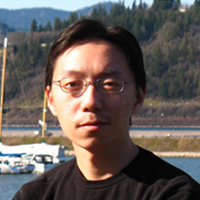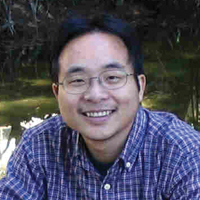Learning How Electronic Materials Deal with Stress
June 24, 2019
Even atoms, it turns out, are not immune to stress. Assistant Professor Jian Liu, together with Associate Professor Haidong Zhou, have won a grant from the Air Force Office of Scientific Research (AFOSR) to investigate the structural changes in nanoscale systems brought on by stress and strain, as well as how those changes influence a material’s electronic properties. The award comes through AFOSR’s Defense University Research Instrumentation Program (DURIP) and will support their efforts to design a more efficient experimental setup for this kind of study.
Squishing and Stretching
Electronic devices continue to shrink in size while gaining power. (Consider, for example, that Apple’s iPhone XS runs on a chip using seven-nanometer technology.) One attractive route to gain intelligent functionality is to utilize complex materials with entwined properties subject to multiple external controls. Scientists like Liu and Zhou dig down to the fundamental physics supporting these devices. By looking at functional materials—those that by nature possess properties like ferroelectricity or magnetism—and studying how they respond to different stimuli, they can better understand how these properties emerge and predict how complex electronic materials can be engineered and controlled. Their DURIP proposal will focus on the big difference small structural changes can have on the properties of crystalline materials—those with a periodic arrangement of atoms. Zhou will grow crystals for the experiments and Liu will study the effects of stress (in simple terms, sort of squishing or stretching the material) and strain, which is the result of that stress. Or, as Liu explains, strain is a change in shape, which means it’s a mechanical process. While we tend to focus on electronics, he said, "our world is incredibly mechanical. (And) studying how a material responds to a mechanical effect is actually very important."


To carry out these studies, Liu will combine critical capabilities and develop customized equipment. He plans to apply continuous stress or strain, which he can tune over a wide range, to the material samples. He will measure how this deforms the samples, but will also look for subtle, atomic displacements in their lattice structure as well as the electronic modulation in resistance.
"These measurements don’t conflict with each other," he explained. "In principle one can do them with the same setup and there should be no problem. The thing is that there is no such setup."
Liu said that typically scientists who want to perform such studies might have to run separate experiments to account for system responses to different external factors like a magnetic field, temperature, or in this case, stress. Then they have to combine the data.
"We’re going to do all this in one shot," he said. "We eliminate all the external complicating factors and then when you take the data you see how the atomic position and the electronic resistance respond simultaneously to the stress. I get to see the internal connection between these two qualities that I want to measure."
To do this, Liu is devising an in-house system. While he and his colleagues often avail themselves of large research facilities like the Advanced Photon Source (APS) at Argonne National Laboratory, there are disadvantages to relying on them.
"The downfall is that you can only have a week of time in several months," he said. "The next user is going to come in to do their own experiment. That means that the setup has to be assembled and disassembled every time, and cannot be too specialized."
He added that a good portion of that week will be spent every time on setting up experiments, leaving less time to actually take measurements.
"This is very inefficient," he continued. "And if you want to study something, it’s very difficult to wait for several months and do this all over again."
Building Out of the Box, Old-School Style
The solution Liu devised is an in-house experiment exploiting the fact that most of the structural distortion measurements he wants to take won’t require an intense x-ray beam like that at the synchrotron. His set-up includes a micron-focused x-ray source aimed at a cryostat, which hosts a stress/strain cell at its fingertip. Inside this cell are samples of materials wired for measurement that will be illuminated when hit by the x-ray beam. The cryostat is mounted on a customized diffractometer, which measures how the x-rays scatter to determine the samples’ structure. As "customized" implies, the diffractometer is not an out-of-the-box, market-ready design, but more of a return to the build-what-you-need school of physics.
"In the old days," Liu explained, "the diffractometer was very customizable. If you go to some old-school professor or (research) group, they probably had one of these very old diffractometers they put together and they designed it to do what they want."
In the past decade or two, however, commercialization has replaced those original pieces of equipment.
"They make it very robust, user-friendly, and easy to train people to use it," he said. "But the problem is that you cannot change anything. We’re trying to bring this knowledge back to an in-house setup."
A custom diffractometer will make it possible for Liu to make the simultaneous measurements he needs. He will also use a micro-focused x-ray source, the reason being that he wants to apply strain to the sample materials, and a large strain requires a small sample, which in turn requires a beam much smaller than a commercialized product. Among other results, this system will help him pin down just how much stress a material can take. As he said, he wants to know, "how, microscopically, do the atoms rearrange themselves to accommodate this shape change?"
The design will interface easily with the beamline at the Advanced Photon Source, so Liu can do preliminary measurements at the UT-Oak Ridge National Laboratory Joint Institute for Advanced Materials (JIAM) and then advanced experiments with the tunable x-ray energy available at the synchrotron, making much more efficient use of his research time at APS and the true value of the synchrotron facility. Another benefit of building customized equipment is helping students understand the fundamental science behind it.
Liu said that with many lab elements that come straight out of a box, "students just don’t know the basic principles and physics behind them."
The experimental proposal in the DURIP setup is the type that would require hands-on training and a grasp of the science before they could use it.
"We can use this as a tool to develop materials for junior level graduate classes and senior level undergraduate classes," he said.
Growing from UT Seeds
The DURIP grant actually builds on initial funding from the UT Office of Research and Engagement. Through the Mission Agency Research Seed Program and the Organized Research Unit Program, they offer UT researchers financial support with the intent to help them generate competitive proposals for federal grants. Liu and Zhou won funding to build a strain cell, a critical element of the experimental setup that ultimately won DURIP funding. For the 2019 fiscal year, the Department of Defense announced awards to 185 university researchers totaling $56 million through the DURIP initiative. Their grant (Microfocused X-Ray Source for Measurements Under In-Situ Strain) was the only one awarded to UT in this funding cycle.
Learn more about the DURIP program and FY19 Awards.